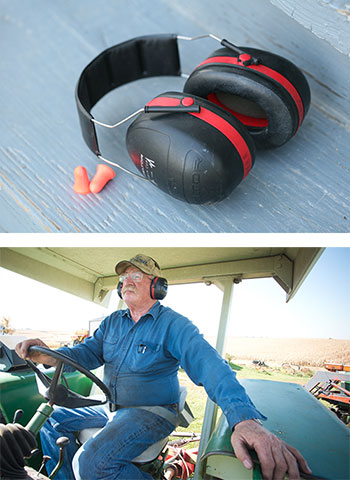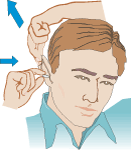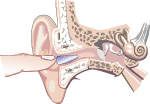Why Should Farmers and Agricultural Workers be Concerned About Hearing Loss?
- Hearing loss from exposure to noise is common among farmers and agricultural worker
- Hearing loss from noise is permanent and irreversible
- Hearing loss causes loss of life quality for farmers and farm families
- For most farmers, hearing loss occurs gradually over many years and may only be noticed once it is a serious problem
- Hearing loss from noise can be prevented
What are the Sources of Hazardous Noise in Agriculture?
Hazardous levels of noise are produced by many kinds of agricultural equipment, including:
- grain dryers
- tractors
- combines
- livestock
- chainsaws
- firearms
What is Too Loud?
Any noise that leaves you with ringing in the ears or a temporary reduction in your hearing is TOO LOUD!
If you are in a noisy location and you have to raise your voice above a normal speaking voice just to be heard, the noise is TOO LOUD!
How is Noise Measured?
The loudness of sound levels are measured in units of “decibels”, abbreviated as dB or dBA.
Sound levels are measured with sound level meters. While these units are expensive, there are now many smartphones apps that can provide an estimate of sound levels.
Sound levels under 85 dBA are generally thought of as “safe,” although there is some risk of hearing loss for prolonged exposures to 80 dBA.
How Can Farmers Protect Their Hearing?
Exposure to noise can be controlled many ways. The following are common methods for agricultural workers:
 Reduce Sound Levels. When selecting new equipment, ask about sound levels and pick the quietest option.
Reduce Sound Levels. When selecting new equipment, ask about sound levels and pick the quietest option.- Perform routine equipment maintenance.For example, fixing mufflers on engines, lubricating bearings, and replacing worn parts will reduce noise levels and improve farmingoperations.
- Isolate yourself from noise. Working in motorized equipment equipped with cabs or enclosures will reduce noise exposure. Open tractors, loaders, and ATV exposure operators to more noise than similar equipment with enclosed cabs.
- Use personal protective equipment.Since purchasing newer, quieter equipment is not always an option, use hearing protection when working in noisy settings. The earmuff style offers the best protection and is easy to use. Expandable ear plugs are the next best option but these require proper insertion to be effective: roll them up, insert into the ear, hold in place while they expand to fill the ear canal.
- Mark “HIGH NOISE ZONE” anywhere there is risk of excessive noise exposure. Have a set of earmuffs or earplugs in or near every high noise setting on the farm. The less trouble hearing protection is to use, the more likely it will be used.
- All hearing protection equipment has a “Noise Reduction Rating”, or “NRR”, usually between 15 and 30 decibels. Chose the hearing protection with the highest NRR value.
- Limit daily exposure duration. Reducing the amount of time you are exposed to noise can limit its harmful effects. The table below shows how the “safe” exposure duration to noise decreases with increasing noise exposures. These times indicate the maximum amount of time someone can be safely exposed to noise when NOT wearing hearing protection.
| Maximum Time/Day | Sound level dB | Examples of noise source at sound levels |
| 2.5 hr | 90 | ATV, push lawn mower |
| 95 min | 92 | Enclosed cab tractor or combine, grain auger |
| 47 min | 95 | Air compressor |
| 30 min | 97 | Shop vacuum |
| 15 min | 100 | Pigs squealing, table saw, irrigation pump |
| 9 min | 102 | Riding lawnmower, pressure washer |
| 4 min | 105 | Tractor, combine (no cab), grain dryer |
| 1.4 min | 110 | Leaf blower, metal grinder |
| <1 min | 115 | Chainsaw |
Adapted from: www.extension.org/pages/62258/hearing-loss-and-protection-for-agricultural-producers(April 2, 2013)
How to Wear Soft Foam Earplugs
 To get the best protection from your soft foam earplugs, remember to roll, pull, and hold when puttingthem in. Use clean hands to keep from getting dirt and germs into your ears!
To get the best protection from your soft foam earplugs, remember to roll, pull, and hold when puttingthem in. Use clean hands to keep from getting dirt and germs into your ears!
- Roll
Roll the earplug up into a small, thin “snake” with your fingers. You can use one or both hands.  Pull
Pull
Pull the top of your ear up and back with your opposite hand to straighten out your ear canal. The rolled-up earplug should slide right in.- Hold
Hold the earplug in with your finger. Count to 20 or 30 out loud while waiting for the plug to expand and fill the ear canal. Your voice will sound muffled when the plug has made a good seal. Check the fit when you’re all done. Most of the foam body of the earplug should be within the ear canal. Try cupping your hands tightly over your ears. If sounds are much more muffled with your hands in place, the earplug may not be sealing properly. Take the earplug out and try again.http://www.cdc.gov/niosh/mining/content/earplug.html (April 1, 2013)
Check the fit when you’re all done. Most of the foam body of the earplug should be within the ear canal. Try cupping your hands tightly over your ears. If sounds are much more muffled with your hands in place, the earplug may not be sealing properly. Take the earplug out and try again.http://www.cdc.gov/niosh/mining/content/earplug.html (April 1, 2013)
Hearing Loss Prevention Resources for Agricultural Workers and Educators
Noise Induced Hearing Loss in Agriculture (Penn State Extension Website)
A description of the hearing process, the harm that noise does to hearing, and ways to prevent hearing loss among agricultural workers.
Young Farmers’ Guide for Selecting and Using Hearing Protection (Centers for Disease Control)
Brochure printable on legal size paper. Explains selecting, fitting, and using hearing protection. Developed for young farmers but of interest to all. Has specific instructions for use of formable earplugs.
Protejase los Oidos (National Agricultural Safety Database)
El texto hace énfasis en los puntos importantes relacionados con la prevención del sentido del oído.
Spanish language version of NASD document. Only Spanish language information currently available.
Protecting Kids’ Hearing on the Farm (Informacion en espanol) (National Institutes of Health)
Information for parents and educators on protecting children’s hearing as well as materials for children including a video (see link, below).
What Does Hearing Loss Sound Like? (Web-based Simulation)
On-line demonstration of the hearing loss. Requires computer with audio capability (speakers).
Sound Meter (Web-based Simulation)
Sounds and sound intensities of everyday objects and how long it takes before a sound becomes dangerous to the human ear. Plays and reports the sound level (in “decibels”) for sounds from a whisper to a rocket launch, including an impact wrench, tractor, shotgun, and chain saw.
Hearing Protector Device Compendium (Web search)
Check out hearing protection by manufacturer or a selected noise level. It will give the product name, model #, Noise Reduction Rating (NNR) value, and a picture of the device. Clicking on the product page will display the model features (respirator compatible, silicone, separate use or care instructions, etc.).
Power Tool Database (Web search)
Search on type of power tool to view sound specifications. Lists by manufacturer and size specifications.
Hearing Loss Prevention Resources for Researchers and Academics
Scholarly Articles
Beckett WS, Chamberlain D, Hallman E, May J, Hwang S, Gomez M, Eberly S, Cox C, Stark A. (2000): Hearing conservation for farmers: Source apportionment of occupational and environmental factors contributing to hearing loss. J Occup Environ Med, 42(8):806-813. PMID: 10953818.
Hearing loss on audiometry was significantly associated with increased age, male gender, education through high school or less, lifetime years of hunting with guns, lifetime years of use of a grain dryer, and a history of spraying crops during the previous year.
Choi SW, Peek-Asa C, Zwerling C, Sprince NL, Rautiainen RH, Whitten PS, Flamme GA. (2005):
A comparison of self-reported hearing and pure tone threshold average in the Iowa Farm Family Health and Hazard Study. J Agromed, 10(3):31-9. PMID: 16537314.
The investigators report the results of a study to assess performance of several self-reported hearing measures to identify hearing loss among 98 male Iowa farmers. The results support the use of simple screening questions to identify hearing loss among farmers.
Crawford JM, Hoppin JA, Alavanja MC, Blair A, Sandler DP, Kamel F. (2008): Hearing Loss Among Licensed Pesticide Applicators in the Agricultural Health Study. J Occup Environ Med, 50(7):817-826. PMID: 18617838.
The analysis extends results of previous reports suggesting that organophosphate exposure increases risk of hearing loss.
Ehlers, J, Graydon P. (2011) Noise-induced hearing loss in agriculture: Creating partnerships to overcome barriers and educate the community on prevention. Noise Health, 13(51): 142-146. PMID: 21368439.
A description of how NIOSH created partnerships to promote hearing conservation among agricultural populations.
Gomez MI, Hwang SA, Sobotova L, Stark AD, May JJ. (2001): A comparison of self-reported hearing loss and audiometry in a cohort of New York farmers. J Speech Lang Hear, 44(6):1201-1208.
The authors examined associations between self-reported hearing loss and pure-tone audiometry among 376 farmers and farm residents. The authors conclude that a simple questionnaire focusing on hearing difficulty is a useful and valid tool for conducting epidemiologic studies of hearing among farmers.
Humann M, Sanderson W, Gerr F, Kelly K, Merchant J. (2012): Effects of common agricultural tasks on measures of hearing loss. Am J Ind Med, 55(10): 904-916. PMID: 22674632.
Multivariable analyses of audiometry and lifetime exposure to 11 agricultural tasks among 1,568 agricultural and rural participants. After controlling for covariates, audiometry-confirmed hearing loss was associated with hunting or target shooting, electric or pneumatic tool use and number of years spent living on a farm.
Hwang S, Gomez M, Sobotova L, Stark A, May J, Hallman E. (2001). Predictors of hearing loss in New York farmers. Am J Ind Med, 40(1):23-31. PMID: 11439394.
The authors report on the analysis of telephone interview data from the New York Farm Family Health and Hazard Surveillance study of 1,616 participants. Self-reported hearing loss was related to farm noise exposure after controlling for confounders and other sources of noise.
Lander LI, Rudnick SN, Perry MJ. (2007): Assessing Noise Exposures in Farm Youths. J Agromed, 12(2):25-32. PMID: 18086651.
Detailed noise exposure assessments were performed among 10 dairy farm youth. Two participants exceeded the OSHA action level. The authors concluded that youths may be exposed to noise levels that exceed adult OSHA permissible exposures level as part of their daily farm activities.
Marlenga B, Linneman JG, Pickett W, Wood DJ, Kirkhorn SR, Broste SK, Knobloch MJ, Berg RL. (2011): Randomized trial of a hearing conservation intervention for rural students: long-term consequences. Pediatrics, 128(5):e1139-46. PMID: 21987700.
A three year hearing conservation intervention delivered high school students in agricultural communities did not result in lower rates of NIHL when compared to control group participants.
Masterson E. (2012): NIOSH Announces First Results from Occupational Hearing Loss Surveillance Project. CAOHC Newsletter, 4(2): 1.
Ongoing study sponsored by NIOSH. NIOSH is still actively partnering with providers willing to share their audiometric data with NIOSH. Contact Liz Masterson at OHLSurveillance@cdc.gov or (513) 841-4291.
May, J. (2000): Occupational hearing loss. Am J Ind Med, 37(1):112-120. PMID: 10573600.
This paper addresses the pathophysiology of noise-induced hearing loss and describes occupational and non-occupational factors which influence a worker’s risk of hearing loss.
McBride DI, Firth HM, Berbison GP. (2003): Noise exposure and hearing loss in Agriculture: A survey of farmers and farm workers in the Southland region of New Zeland. J Occup Environ Med. 45:1281-1288.
A cross sectional study of noise exposure and hearing function among farm workers. Age, driving tractors without cabs, and working with metal were associated with hearing loss.
McCullagh MC. (2012): Validation of a questionnaire to identify hearing loss among farm operators. Noise Health, 14(56):32-8. PMID: 22387711.
The 10-item National Institute of Deafness and Communication Disorders self-administered questionnaire, while less desirable than audiometry, may be useful as an alternative screening method to detect hearing loss and identify the need for medical evaluation of hearing acuity, particularly among farm operators.
McCullagh MC, Ronis DL, Lusk SL. (2010): Predictors of use of hearing protection among a representative sample of farmers. Res Nurs Health, 33(6):528-38. PMID: 21053386.
Among 532 farmers in the upper Midwest hearing protection use was relatively low, with 57% reporting ever having used hearing protection equipment. The availability of hearing protectors was strongly associated with greater use of hearing protection.
Murphy DJ, May J. (1995): Occupational noise exposure in dairy farming. In McDuffie, H., Dosman, J., et al. (Eds.), Human Sustainability in Agriculture: Health, Safety, Environment. pp. 363-368. Chelsea, MI: Lewis Publishers.
Overview of occupational noise in dairy farming.
Perry, MJ, May JJ. (2005): Noise and chemical induced hearing loss: special considerations for farm youth. J Agromed, 10(2), 49-55. PMID: 16236671.
A literature review reporting on noise and chemical hazards that affect hearing among farm youth.
Sprince NL, Park H, Zwerling C, Lynch CF, Whitten PA, Thu K, Gillette PP, Burmeister LF, Alavanja MCR. (2002): Risk factors for machinery-related injury among Iowa livestock farmers: a case-control study nested in the Agricultural Health Study. Int J Occup Environ Health, 8:332-338. PMID: 12412851.
The investigators report on associations between machinery-related injury and hearing impairment, problem drinking, and fewer years of farming experience.
Sprince NL, Park H, Zwerling C, Lynch CF, Whitten PA, Thu K, Burmeister LF, Gillette PP, Alavanja MCR. (2003): Risk factors for animal-related injury among Iowa livestock farmers: a case-control study nested in the Agricultural Health Study. J Rural Health, 19(2):165-173. PMID: 12696853.
Associations were observed between animal-related injury and a younger age, hearing difficulties, and doctor-diagnosed arthritis.
Sprince, NL, Zwerling C, Lynch CF, Whitten PA, Thu K, Logsden-Sackett N, Burmeister LF, Sandler DP, Alavanja MCR. (2003): Risk factors for agricultural injury: a case-control analysis of Iowa farmers in the Agricultural Health Study. J Agric Saf Health, 9(1):5-18. PMID: 12673912.
Results confirm the importance of risk factors identified in previous analytic studies and suggest directions for future preventive intervention strategies to reduce farm work-related injuries.
Sprince NL, Park H, Zwerling C, Lynch CF, Whitten PA, Thu K, Gillette PP, Burmeister LF, Alavanja MCR. (2003): Risk factors for falls among Iowa farmers: a case-control study nested in the Agricultural Health Study. Am J Ind Med, 44:265-272. PMID: 12929146.
Aging and health impairments, including hearing loss, were risk factors falls among farmers.
Sprince N, Park H, Zwerling C, Whitten P, Lynch C, Burmeister L, Thu K, Gillette P, Alavanja M. (2007): Risk factors for low back injury among farmers in Iowa: a case-control study nested in the Agricultural Health Study. J Occup Environ Hyg, 4(1):10-6. PMID: 17162476.
Age less than 45 years, doctor-diagnosed asthma, education beyond high school, and difficulty hearing normal conversation were significantly associated with low back injury among participants in the Agricultural Health Study.
Voaklander DC, Umbarger-Mackey ML, Wilson ML. (2009): Health, medication use, and agricultural injury. Am J of Ind Med, 52(11):876-89. Doi: 10.1002/ajim.20749.
A review of English language literature in Medline, CINAHL, and NIOSH databases showed health- and disease-related factors most commonly reported as significantly contributing to agricultural injury included previous injury, hearing problems, depression, arthritis, and sleep deprivation.
